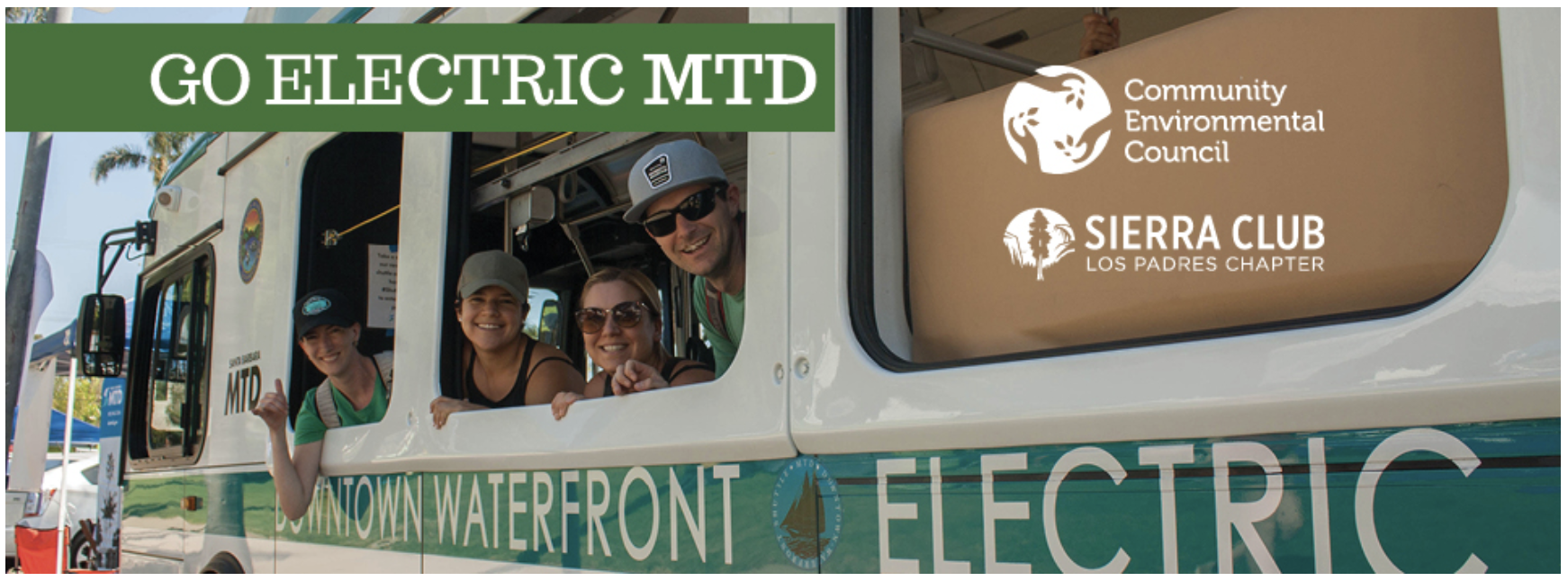WIN: Go electric MTD #driveclean
Update:
Santa Barbara Metropolitan Transit District voted unanimously to set a goal of 100% all-electric buses by 2030, joining Los Angeles and seven other California Transit Agencies. Setting this goal will lead to cleaner air, cut climate pollution, improve the health of our region’s residents, and increase jobs. Read the press release here.
See the presentation CEC made to the MTD Board of Directors to learn more about how this decision will help our region.
Original Alert:
This is the petition we sent to urge SB MTD to transition to 100% electric buses by 2030.
To: Jerry Estrada, General ManagerDave Davis, Chair of the Board of DirectorsSanta Barbara Metropolitan Transit District550 Olive StreetSanta Barbara CA 93101
Re: Electric Bus Fleet for MTD
SEPTEMBER 2018
Dear Mr. Estrada and Mr. Davis:
Santa Barbara MTD is known as an award-winning transit system that continues to adapt to the public’s mobility, comfort, and health needs. We, the undersigned, urge you to continue Santa Barbara MTD’s tradition of innovation and customer satisfaction by setting a goal of 100% zero-emission buses (ZEBs) by 2030 for these reasons:
Zero-emission buses have no tailpipe and therefore emit no air pollutants. Diesel exhaust contains more than forty toxic air contaminants that can cause and/or worsen diseases such as asthma and cancer. Air pollution disproportionately impacts low-income neighborhoods and communities of color in California cities.
Zero-emission buses reduce carbon emissions 74% compared to diesel buses, based on today’s electricity sources. Electrifying the bus fleet will help Santa Barbara County and its cities meet their climate goals. In future years, zero-emission buses will decrease carbon emissions even more as the electrical grid becomes greener. The Cities of Santa Barbara and Goleta have committed to a goal of 100% clean energy by 2030. In California, it’s 100% by 2045.
Zero-emission buses save money. ZEBs currently only cost $100,000 to $150,000 more than hybrid-diesel buses but save $400,000 on fuel and maintenance costs during the bus’s lifetime. The up-front cost differential is expected to narrow significantly in the next 12 years. These substantial operational savings can be used by transit agencies to expand their electric fleet. In addition, all-electric buses have fuel efficiencies four times greater than diesel and CNG buses.
Zero-emission buses will improve the quality of life in neighborhoods. They are not only cleaner and emit lower pollutants that worsen conditions such as asthma, but are also quieter. ZEBs also provide better handling and a more comfortable ride. Zero-emission buses rely on electricity from domestic sources of energy and keep the energy-related profits and jobs here in California. Moreover, incentive funding is now available through State, Federal and soon through VW Settlement funds.
Eight California agencies, including Los Angeles Metro (the largest transit agency with one quarter of all transit buses in California), have set goals of 100% Zero Emission buses by 2030. Porterville and Antelope Valley Transit Agency (AVTA), have both committed to become the nation’s first fully electric fleets by 2018. California is going 100% electric, and we should join them. Thank you for your attention regarding this important and timely community issue.
http://www.ucsusa.org/sites/default/files/attach/2016/10/UCS-Electric-Buses-Report.pdf
http://www.ucsusa.org/sites/default/files/attach/2016/10/UCS-Electric-Buses-Report.pdf
https://www.transportation.gov/r2ze/benefits-of-ZEBs
The Background: Electric Bus Goals in California
With the Innovative Clean Transit rule at the California Air Resources Board and Governor Brown’s Executive Order that now sets a goal for complete carbon neutrality in all sectors by 2045, it is no longer a question of whether transit agencies can switch to zero emissions, but when they will transition. Currently, in the state of California, 132 battery and fuel cell electric buses are in operation, with 655 on order, awarded, or planned as of May 2018. Agencies like Los Angeles Metro Transit and Foothill Transit – representing more than ⅓ of California’s 10,000 buses – have now committed to 100% electric buses by 2030. At least two agencies, including Antelope Valley Transit Agency, have committed to this goal by 2018.
The Opportunity: 100% Electric Bus Goal for MTD
Santa Barbara MTD has been a leader in California, with electric buses already operating. Following suit with groups like Los Angeles Metro District will maintain SBMTD’s electric vehicle leadership. It will also allow the agency to:
Take advantage of early incentives and grants
Assist Santa Barbara County in reaching our greenhouse gas goals
Reduce the agency’s total cost of ownership, while creating a robust market for clean buses that drives down prices
Our local public has already voiced support of the electric buses in MTD’s fleets, noting that they are quieter inside and out with a smoother ride, and that they eliminate unhealthy tailpipe emissions for drivers and passengers alike. In addition, moving more quickly to achieving a 100% electric fleet creates jobs in California. Housing 3 out of the 4 leading electric bus makers, our state is the electric bus manufacturing capital of the nation. The proximity of these manufacturers improves the logistics of acquiring new electric buses.
Want to take more action? Attend an SB MTD public meeting!
Speak at the next Santa Barbara MTD Transit Meeting.
Date: Tuesday, November 20
Location: Santa Barbara MTD Building – 550 Olive St.
Time: 8:30 a.m.
Fill out a speaker slip and prepare to talk for two minutes about why electric buses are important to you and our community. Ask MTD to set a 100% EV Bus goal by 2030, and use any of the talking points that resonate with you. If you ride the bus, tell them which line and how it helps you!
